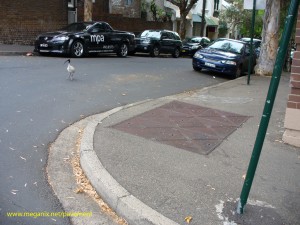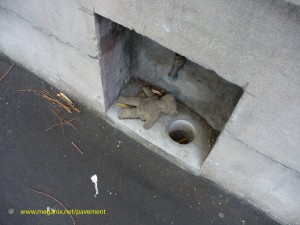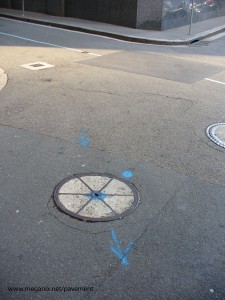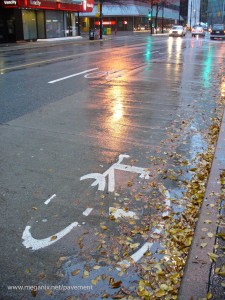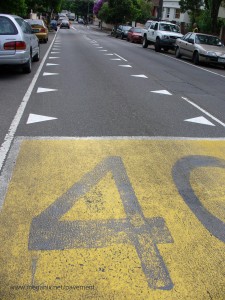 Now here’s a colourfully interesting grouping of pavement and close-to-pavement graffiti in Enmore. A gnomish amputee in paper, a soda siphon stencil, a cement cast – presumably by guerrilla artist Numb – and mauve crowns and circles. Mauve is an unusual colour for pavement graffiti and not particularly distinct on the mottled concrete. Did Numb add these embellishments to his own work or was the violet (not violent) spray-painter an admirer who came along afterwards?
Now here’s a colourfully interesting grouping of pavement and close-to-pavement graffiti in Enmore. A gnomish amputee in paper, a soda siphon stencil, a cement cast – presumably by guerrilla artist Numb – and mauve crowns and circles. Mauve is an unusual colour for pavement graffiti and not particularly distinct on the mottled concrete. Did Numb add these embellishments to his own work or was the violet (not violent) spray-painter an admirer who came along afterwards?
In the ten years since I became obsessed with pavement inscriptions I’ve taken hundreds of photographs. With so many to choose from it’s not too hard to find examples to illustrate any point I might want to make when I write about the pavement as a medium for expression.
But what if I took a walk on an arbitrary route from an arbitrary starting point and photographed every picture, sign and scribble on the pavement along the way? Would that series of unselected inscriptions unfold as a coherent story?
I tried this as an experiment for the Open Fields forum at UTS (University of Technology, Sydney). I started in Surry Hills at a street with a very common name, Smith Street, and took a zig-zag route in a direction away from the centre of the city. I got as far as Waterloo, only about 2 km as the ibis flies, but I had taken more than 3 hours and photographed around 150 pavement inscriptions.
I made a slide show of these Unselected readings in the order in which I found them. But here’s a confession: although I stuck to my arbitrary rules for the day pretty well, I did stop photographing every manhole cover and every wet cement inscription, because there were so many of them.
What did I find out from this experiment? Well, perhaps I will talk about that in future blog entries.
I’ve looked at manholes from both sides now, from down and up, and still somehow…
 On 18 April I was lucky enough go on an underground tour of the Tank Stream. The Historic Houses Trust runs these tours twice a year in conjunction with Sydney Water and they are so popular that you have to enter a ballot to get a ticket. You don’t go far – just 50 metres upstream from the ladder where you descend into the underground tunnel. The Tank Stream was the original source of fresh water that determined the location of Sydney Town, but during the two centuries since then it has evolved from stream to open sewer, to closed-in sewer, and currently it is a stormwater drain. Â
On 18 April I was lucky enough go on an underground tour of the Tank Stream. The Historic Houses Trust runs these tours twice a year in conjunction with Sydney Water and they are so popular that you have to enter a ballot to get a ticket. You don’t go far – just 50 metres upstream from the ladder where you descend into the underground tunnel. The Tank Stream was the original source of fresh water that determined the location of Sydney Town, but during the two centuries since then it has evolved from stream to open sewer, to closed-in sewer, and currently it is a stormwater drain. Â
Sloshing along in borrowed gumboots, instead of looking down, as I usually do when I’m spotting pavement graffiti, this time I was looking up to see what manhole covers look like on the underside. Afterwards a Sydney Water worker helped me identify which covers we had walked beneath.
Admiration of manhole covers became a popular pastime in the 1990s.  Mimi and Robert Melnick’s 1974 Manhole covers of Los Angeles has become a collectors item, but their 1994 book Manhole covers and Jacopo Pavesi and Roberta Pietrobelli’s 2001 book Street covers brought cast-iron style to the coffee table. The minor mania for manhole covers has culminated in book titles ranging from Designs underfoot: the art of manhole covers in New York City to Quilting with manhole covers: a treasure trove of unique designs from the streets of Japan.
In picture books the manhole covers are brushed up for the camera, but like Japanese artist Genpei, I prefer the look of them in their natural state, with cigarettes and Smarties and tsubo gardens of moss, grass or weeds nestling in their grooves.
Â
My very favourites are the pretend manhole covers that mark the place of the real thing when a road is being resurfaced.
I also love the website Misplaced Manhole Covers.
It’s a big old house divided into a warren of flatettes, in an increasingly desirable inner-west neighbourhood. The last low-rent place in a street where the house next door was the first to hit the one million dollar mark ten years ago. It has its share of excitement – the police, fire brigade or ambulance visit at least once a month, sirens screaming. There’s often shouting – in the house or on the street. There always seems to be rubbish piled out the front. Other people in the street mutter about how they wish ‘those people’ would go. But someone died there last month and someone cared enough to memorialise him on the footpath.
 In an earlier guest blog, Bradley L. Garrett revealed his excitement upon discovering a pavement penis. Well, there’s a lot of them about.  These examples are in the inner Sydney suburb of Redfern, where encroaching trendiness has turned a closed-off street beside the railway line into an official bicycle route and a parking lot for cultural-industry workers and the newer type of resident.
In an earlier guest blog, Bradley L. Garrett revealed his excitement upon discovering a pavement penis. Well, there’s a lot of them about.  These examples are in the inner Sydney suburb of Redfern, where encroaching trendiness has turned a closed-off street beside the railway line into an official bicycle route and a parking lot for cultural-industry workers and the newer type of resident.
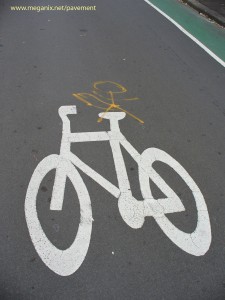 Older established residents and their offspring may well feel resentful. I choose to believe that these alterations of official traffic signs express a local belief that the car parkers and cyclists are wankers.
Older established residents and their offspring may well feel resentful. I choose to believe that these alterations of official traffic signs express a local belief that the car parkers and cyclists are wankers.
 Camperdown Park, in inner western Sydney, is famous for the graffiti on the sandstone walls separating it from the St Stephens Church Cemetery. I have a book published in 1975 (Ellis & Turner, Australian Graffiti) with a black and white photo of graffiti messages in large lettering on this wall like ‘Love is a many gendered thing’ and ‘Is there life after marriage?’
Camperdown Park, in inner western Sydney, is famous for the graffiti on the sandstone walls separating it from the St Stephens Church Cemetery. I have a book published in 1975 (Ellis & Turner, Australian Graffiti) with a black and white photo of graffiti messages in large lettering on this wall like ‘Love is a many gendered thing’ and ‘Is there life after marriage?’
These days the political and often witty statements have been joined by more up-to-date styles of graffiti like ‘balloon’ lettering and stencils. The graffiti has also crept onto the paths in the park. It soon gets obliterated by pedestrians and cyclists, but three years ago I happened to capture the faint remnants of this one, which seems to have been written by a person who was either very happy, or needed to make a statement, or both.
Today’s guest spotter is Bradley L. Garrett, a PhD student at Royal Holloway, University of London, where he is studying Urban Exploration. Bradley’s own blog is here.
 I have lived in Clapham, in South London, just across the street from Clapham Common (a huge park) for about eight months now and six months ago I bought a bicycle. This was a significant event because it meant that I no longer took the bus to Clapham Junction train station, I now rode my bike through the park every day instead in what I thought to be a small victory over mundanity.
I have lived in Clapham, in South London, just across the street from Clapham Common (a huge park) for about eight months now and six months ago I bought a bicycle. This was a significant event because it meant that I no longer took the bus to Clapham Junction train station, I now rode my bike through the park every day instead in what I thought to be a small victory over mundanity.
The first time I encountered the little freehand graffiti penis was on one such ride. I was listening to an audio lecture by Arnold Weinstein about Baudelaire’s poem The Swan and here comes this phallus, standing erect in the road like a raucous troll, exacting some sort of fare I was sure. But how to pay it? Figuring all it wanted was some attention I photographed it and moved on.
For six months now I have encountered this masculine assemblage, swerving around it at the last second, sure that, like some form of voodoo charm, it would hurt somebody if I ran over it. Sometimes I would remember it before my encounter, anxious to see if it finally had aroused enough offence in the community to have it painted over. Every once and a while I would stop next to it, seemingly not of my own accord, and stare around, wondering what sort of thought or action it was meant to invoke, feeling like someone was watching and noting my confusion with pleasure. One biker stops, check.
It’s almost mathematical in is perfect pointedness. Even the fact that one testicle hangs slightly lower than the other seems to me to be anatomically correct. Thinking that after months of study, I had now understood its form, my analysis of the thing moved on to function more seriously. The phallus points straight down the asphalt path. My first inclination was, of course, to assume that it points the way to something. Perhaps it was the remnant of a petty birthday party joke, a Facebook tagline proclaiming “when you arrive in Clapham Common, follow the penis to Dave’s party.†Later, I began to wonder if the trajectory of the penis was subsidiary to its location. Could it be a meeting point of some sort?
This notion seemed to be reinforced by my mate Mike over drinks one night who proclaimed Clapham Common as a place where gay men go to “get bummed†which in America (where I come from) means to be depressed but here is some euphemism for anal sex. Could it be that this innocuous little sign I swerved around everyday was a meeting point for clandestine homosexual encounters at night? Perhaps one day, I thought to myself, I would conduct a 24-hour stakeout to satisfy my need to unravel this mystery.
Finally last week, wrapped up in sweaters, scarves and gloves, in some strange sociological crisis, I did indeed undertake such a weird experiment. What happened was this: just across from the white penile package, there is a park bench which, if you were to sit on it, positions you perfectly to observe the sign (or encounters with the sign). I sat there on a lazy Sunday, pretending to read a book so that I could view interaction with it. And what I saw disturbed me.
Time after time, whether confronted by pram pushing Mommies, solitary walkers or ambitious runners, no one noticed the phallus. They rolled over it, stepped on it and ran past it without even a glance. Thinking that maybe I had, in some sick vision, just imagined the damn thing, I walked over to it. Still there. And then what I saw gave me the shivers.
A second phallus, just up and to the left, barely visible, but there. Even worse, it was a different colour and facing a different direction! How could I have missed this before? Horribly disturbed by the new revelation, I walked home, sullen, curious as to what kind of ghastly person would sketch a pair of horrors like this, knowing the frustration their presence would invoke.
[Now that Bradley has pointed out this parkland penis in London, the Pavement Graffiti blog site will return to the subject of street wangs from time to time]
Street haunting in winter, writes Virginia Woolf, is the greatest of adventures. In the early evening she rambles, her eyes “gliding smoothly on the surface†of things and noticing, for example, that “here under the lamps are floating islands of pale lightâ€.*
One of the loveliest qualities of the pavement is the way it reflects the glow from lights in the street at gloomy times of the day, especially when it is wet. Clarice Beckett captures these reflections in her subtle paintings of Melbourne scenes, like Wet evening c.1927 and Taxi rank c.1931.
A single tail light or traffic light can form a wavering pillar submerged in the depths beneath the surface of the street.
Â
*Street haunting: a London adventure, first published in 1942 and reproduced in The art of the personal essay, Anchor Books, 1995.
Rows of triangular marks have just been planted on roads in the Inner West. I had to do a bit of research to find out that they are Dragon’s Teeth. To date no fully armed warriors have sprung from the asphalt.
The lexicon of official road signs continues to grow. The rollout of this latest addition apparently began in mid-2009, when the RTA’s press release was dutifully rendered as a news story in the Sydney Morning Herald. These triangular markings are meant to indicate to motorists that they are entering a 40 kmh school zone.
The indignant Mr Peter Olsen, on his School Zone Santa.Com blog, reckons that “the Government has completely lost the plot on school zones. Static markings, including the proposed new ‘dragon’s teeth’ achieve nothing because they do not distinguish between school zone hours and non-school zone hoursâ€, whereas if the school zone instead has flashing lights during the relevant hours “drivers are instantly reminded and can slow down, but then of course the Government can no longer collect speeding fine revenue from themâ€.
Note to apostrophe pedants: Dragon’s Teeth is the official New South Wales Government term for these road marks (see Technical Direction TD 2009 SR02). There is only one dragon involved. It is a particular toothy dragon.

